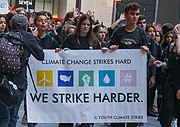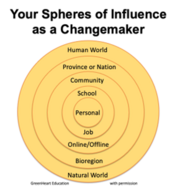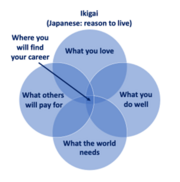BaCCC/Module 7/Lesson 2/Part 1
Module 7, Lesson 2: Becoming a Climate Change Communicator and Ambassador, Part 1
Introduction
Lesson 2 will provide more information and guidance to enable and empower you as a budding climate change communicator and ambassador.
This lesson focuses on how your understanding of the United Nations Action for Climate Empowerment (ACE) paves the way for opportunities. Lesson 2 will also touch on how you can make use of all available information and platforms to forward your intention to become a climate change influencer. Media literacy and the ability to understand and use effective climate change communication skills will ensure and increase the success rate for all your ideas and plans as you lay these out for action.
Take heart . . . you are almost there!
Terminology
The following terms are important in understanding the science behind climate change. If you want to remember them, write their meanings in your learning journal as you encounter them in the course content.
- climate literacy
- denial
- event organising
- media literacy
- multiple intelligences
- social media
- spheres of influence
Multiple intelligences and spheres of influence
To start off this lesson, take the Story of Stuff Changemaker Quiz at:
How do we create change in the world? First, we must know our strengths. What gifts do you bring to the world? What kind of changemaker are you?
The world needs
- instigators or warriors (e.g., the first people to take a stand against an injustice)
- leaders, persuaders or inspirers
- organisers
- networkers or connectors (e.g., people who know how to bring the right people together)
- nurturers (e.g., people who remember to bring snacks and the first aid kit)
- builders (e.g., people who construct the signs for the artists to paint)
- communicators, writers, poets and artists
- investigators or researchers
- resisters or demonstrators (e.g., people who march in demonstrations and protests)
- patrons (e.g., people who can give regular financial support)
The world also needs many different types of intelligence if we are to meet the innumerable challenges currently facing us.
|
The theory of multiple intelligences proposes that everyone is intelligent in different ways. And we each use our own combination of intelligences (most of us are strongest in about three different types of intelligence) in diverse ways. We all have a unique style of thinking, as well as understanding and interacting with the world. Finding out what your strengths are can help you find your place as a climate change champion. (Note: This is about intelligence type, not intelligence level. But if you are taking this course, we know you are super bright!) 1. Bodily-kinesthetic intelligence – good at dance, sports and physical co-ordination 2. Existential intelligence – good at figuring out how the world works 3. Interpersonal intelligence – really good with people 4. Intrapersonal intelligence – good at knowing and understanding oneself 5. Linguistic intelligence – good with language 6. Logical-mathematical intelligence – good with numbers and logic 7. Musical intelligence – good with music and rhythm 8. Naturalist intelligence – good at recognising patterns, especially in the natural world 9. Spatial intelligence – good at art and making sense of the physical world |
|
Next, think about your spheres of influence – the areas of your life in which you can have an influence on others. 1. Starting at the centre of the circle, you can influence yourself, of course, but there is also your immediate family (under the same roof), your extended family (those you do not live with) and your closest friends. Your loved ones notice what you do and what choices you make. 2. You can have influence over your classmates at school, your colleagues at work and the people you socialise with. You can set an example without even knowing it. 3. You can have some influence within your community or communities, both “real” and online (though we are not talking about online “influencers,” since so many of them these days are promoting silly, over-consumptive lifestyles). Your conversations online and offline can “plant seeds” that “grow” in other people’s choices and actions. 4. You can help to create change at different political levels, as well as in your bioregion (by participating in Nature conservation and restoration activities, for example). 5. And by becoming a climate change champion, your positive influence will have an impact on both the human world and the rest of Nature. (Note: Did you see how we twice used the word “Nature” with a capital N? That might have influenced you subconsciously to value Nature more highly. And the expression “humans and the rest of Nature” is meant to help people see that our species is a part of Nature, not apart from Nature. Sometimes, tiny changes amplified and multiplied can be as important as one big change.) |
If you have trouble accessing the video, a summary is available below.
H5P Object Parameters
The H5P parameters below will be replaced by the actual H5P object when it's rendered on the WordPress site to which it's been snapshotted.
If you have trouble accessing the video, a summary is available below.
H5P Object Parameters
The H5P parameters below will be replaced by the actual H5P object when it's rendered on the WordPress site to which it's been snapshotted.
If you have trouble accessing the video, a summary is available below.
H5P Object Parameters
The H5P parameters below will be replaced by the actual H5P object when it's rendered on the WordPress site to which it's been snapshotted.
If you have trouble accessing the video, a summary is available below.
H5P Object Parameters
The H5P parameters below will be replaced by the actual H5P object when it's rendered on the WordPress site to which it's been snapshotted.
(You can adjust the playback speed and/or turn on subtitles/captions.)
If you have trouble accessing the video, a summary is available below.
H5P Object Parameters
The H5P parameters below will be replaced by the actual H5P object when it's rendered on the WordPress site to which it's been snapshotted.
And here is one final way to figure out how you might like to contribute to the world of action on climate change. It is a Japanese concept that translates into “reason to live.” The belief is that your best career choice will be at the intersection of your answers to four questions:
1. What do you love, and what do you love doing?
2. What do you do well?
3. What does the world need?
4. What will others pay you for?
If you remove the last question, the other three questions will certainly help you find the ideal volunteer position in the climate change movement.
References
- ↑ Story of Stuff, n.d. Changemaker Quiz
- ↑ alis.alberta, n.d. Multiple Intelligences Quiz
- ↑ Personality Max, n.d. Multiple Intelligences Test
- ↑ MentalUp, n.d. Multiple Intelligence Theory and Types of Intelligence




